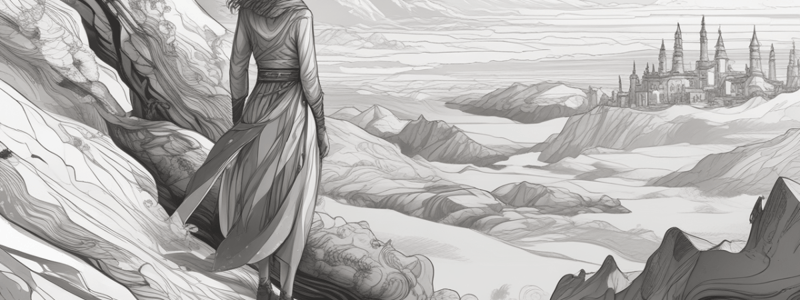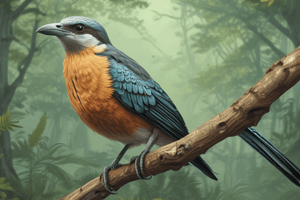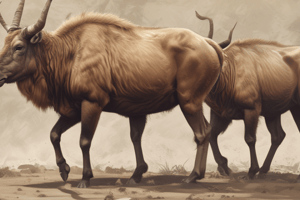Podcast
Questions and Answers
What is one of the adaptations in mammals that allows for greater sideways flexion and up and down flexion?
What is one of the adaptations in mammals that allows for greater sideways flexion and up and down flexion?
- Development of a secondary palate
- Fewer ribs attached to the spine (correct)
- Elongation of limbs
- Presence of a four-chambered heart
What is the function of the Loop of Henle in the kidney?
What is the function of the Loop of Henle in the kidney?
- To regulate body temperature
- To concentrate urine and facilitate water and ion retention (correct)
- To filter oxygen from the blood
- To produce hormones for growth
What is a characteristic of the urogenital system of marsupials?
What is a characteristic of the urogenital system of marsupials?
- Separate exit for the alimentary canal and urogenital opening
- Three separate openings
- Common urogenital opening and two lateral vaginas (correct)
- No external opening for the urogenital system
What is the function of specialized skin glands in mammals?
What is the function of specialized skin glands in mammals?
What is a characteristic of the penis shape in many male marsupials?
What is a characteristic of the penis shape in many male marsupials?
What is a characteristic of placental mammals?
What is a characteristic of placental mammals?
What is a characteristic of the vertebral column in mammals?
What is a characteristic of the vertebral column in mammals?
What is a characteristic of monotremes?
What is a characteristic of monotremes?
What is the primary function of the placenta in mammals?
What is the primary function of the placenta in mammals?
Which of the following characteristics is shared by all mammals, but not necessarily by other taxonomic groups?
Which of the following characteristics is shared by all mammals, but not necessarily by other taxonomic groups?
What is the term for the maintenance of a relatively constant body temperature in mammals?
What is the term for the maintenance of a relatively constant body temperature in mammals?
Which type of placenta is characteristic of marsupials?
Which type of placenta is characteristic of marsupials?
What is the term for the growth of teeth continuously throughout life?
What is the term for the growth of teeth continuously throughout life?
Which of the following is NOT a characteristic of monotremes?
Which of the following is NOT a characteristic of monotremes?
What is the consequence of endothermy and homeothermy in mammals?
What is the consequence of endothermy and homeothermy in mammals?
Which of the following is a characteristic of mammalian red blood cells?
Which of the following is a characteristic of mammalian red blood cells?
What is the primary function of the muscular diaphragm in mammals?
What is the primary function of the muscular diaphragm in mammals?
Which characteristic is unique to placental mammals?
Which characteristic is unique to placental mammals?
What is the significance of fur in mammals?
What is the significance of fur in mammals?
Which of the following is a characteristic of mammalian dental morphology?
Which of the following is a characteristic of mammalian dental morphology?
What is the consequence of endothermy and homeothermy in mammals?
What is the consequence of endothermy and homeothermy in mammals?
Which of the following is a characteristic shared by all mammals?
Which of the following is a characteristic shared by all mammals?
In which group of mammals do males lactate?
In which group of mammals do males lactate?
What is the characteristic feature of mammalian red blood cells?
What is the characteristic feature of mammalian red blood cells?
What is a characteristic of the four-chambered heart found in mammals?
What is a characteristic of the four-chambered heart found in mammals?
Which feature of the vertebral column allows for greater flexibility in mammals?
Which feature of the vertebral column allows for greater flexibility in mammals?
What is the primary function of the secondary palate in mammals?
What is the primary function of the secondary palate in mammals?
Which feature of the skeletal system is characteristic of digitigrade posture in many mammals?
Which feature of the skeletal system is characteristic of digitigrade posture in many mammals?
What is the primary function of the complex lung in mammals?
What is the primary function of the complex lung in mammals?
What is a characteristic of the urogenital system of placental mammals?
What is a characteristic of the urogenital system of placental mammals?
What is the primary function of specialized skin glands in mammals?
What is the primary function of specialized skin glands in mammals?
Which group of mammals lays eggs?
Which group of mammals lays eggs?
Flashcards are hidden until you start studying
Study Notes
Mammal Characteristics
- There are 11 mammal-specific characteristics that distinguish mammals from other animals.
- Three major mammal groups are: monotremes, marsupials, and placental mammals.
Body Features
- Mammals have fur, which may be highly specialized or appear to be absent, but always present in some form.
- Single bone in the lower jaw is a characteristic of mammals.
- Heterodonty is present in some mammals, with some species being secondarily homodontic or having lost teeth altogether.
- Dentary-squamosal jaw articulation is a unique feature of mammals.
Reproductive Features
- Placenta is present in mammals, with marsupials having a choriovitelline placenta and placental mammals having a chorioallantoic placenta.
- This difference in placenta development results in marsupial young being born at a very early stage of development.
- Mammae are present in all mammals, with milk secretion being a characteristic of mammals.
Circulatory System
- Single major artery leaves the heart and branches to the left in mammals.
- Enucleated red blood cells are a characteristic of mammals.
Other Characteristics
- Basic body plan of mammals includes a backbone/spinal column, bilaterally symmetrical body, and four limbs.
- Endothermy and homeothermy are present in mammals, allowing them to colonize 'hostile' habitats.
- Maintenance of a relatively constant body temperature requires lots of energy and is associated with changes in features involved with food acquisition, processing, and waste elimination.
Skeletal Features
- Changes to the vertebral column include fewer ribs attached to the spine, reducing body mass and allowing for greater flexibility.
- Cranial changes include a secondary palate, which separates breathing and eating and facilitates improved communication.
Cardio-Vascular System
- Mammals have a four-chambered heart, which is also seen in birds and some reptiles.
Respiratory System
- Complex lung increases the efficiency of gaseous exchange.
Urogenital System
- Waste excretion is facilitated by the Loop of Henle in the kidney, allowing for concentrated urine and water and ion retention.
- Monotremes have a single external opening, while marsupials have separate exits for the alimentary canal and a common urogenital opening, and placental mammals have three separate openings.
Skin and Other Features
- Skin glands are specialized for temperature regulation and are also used in communication and rearing of offspring.
- Viviparity (birth of live young) is seen in some mammals, while others are oviparous (egg-laying).
Mammal Characteristics
- There are 11 mammal-specific characteristics that distinguish mammals from other animals.
- Three major mammal groups are: monotremes, marsupials, and placental mammals.
Body Features
- Mammals have fur, which may be highly specialized or appear to be absent, but always present in some form.
- Single bone in the lower jaw is a characteristic of mammals.
- Heterodonty is present in some mammals, with some species being secondarily homodontic or having lost teeth altogether.
- Dentary-squamosal jaw articulation is a unique feature of mammals.
Reproductive Features
- Placenta is present in mammals, with marsupials having a choriovitelline placenta and placental mammals having a chorioallantoic placenta.
- This difference in placenta development results in marsupial young being born at a very early stage of development.
- Mammae are present in all mammals, with milk secretion being a characteristic of mammals.
Circulatory System
- Single major artery leaves the heart and branches to the left in mammals.
- Enucleated red blood cells are a characteristic of mammals.
Other Characteristics
- Basic body plan of mammals includes a backbone/spinal column, bilaterally symmetrical body, and four limbs.
- Endothermy and homeothermy are present in mammals, allowing them to colonize 'hostile' habitats.
- Maintenance of a relatively constant body temperature requires lots of energy and is associated with changes in features involved with food acquisition, processing, and waste elimination.
Skeletal Features
- Changes to the vertebral column include fewer ribs attached to the spine, reducing body mass and allowing for greater flexibility.
- Cranial changes include a secondary palate, which separates breathing and eating and facilitates improved communication.
Cardio-Vascular System
- Mammals have a four-chambered heart, which is also seen in birds and some reptiles.
Respiratory System
- Complex lung increases the efficiency of gaseous exchange.
Urogenital System
- Waste excretion is facilitated by the Loop of Henle in the kidney, allowing for concentrated urine and water and ion retention.
- Monotremes have a single external opening, while marsupials have separate exits for the alimentary canal and a common urogenital opening, and placental mammals have three separate openings.
Skin and Other Features
- Skin glands are specialized for temperature regulation and are also used in communication and rearing of offspring.
- Viviparity (birth of live young) is seen in some mammals, while others are oviparous (egg-laying).
Studying That Suits You
Use AI to generate personalized quizzes and flashcards to suit your learning preferences.




